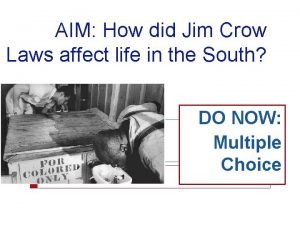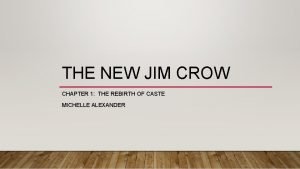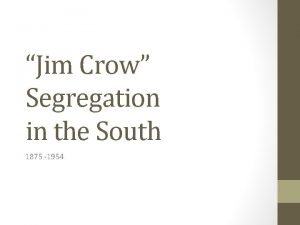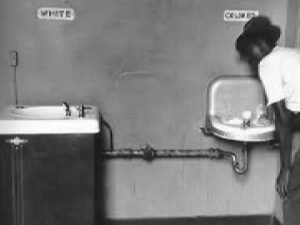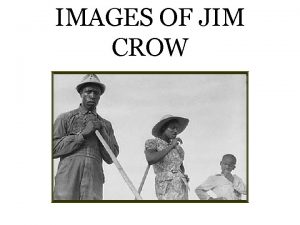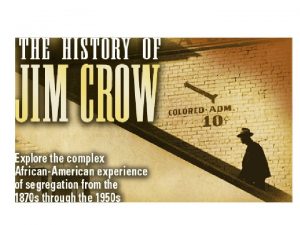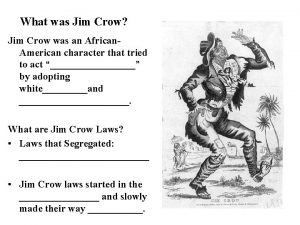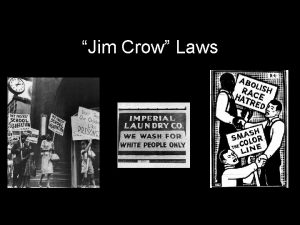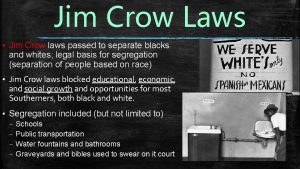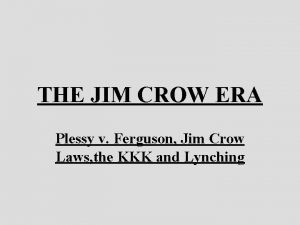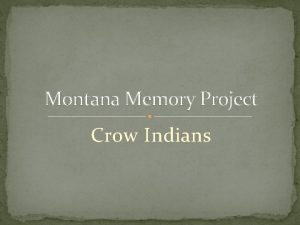The Jim Crow figure was a fixture of





















































- Slides: 53


The "Jim Crow" figure was a fixture of the minstrel shows that toured the South; a white man made up as a black man sang and mimicked stereotypical behavior in the name of comedy.

Sheet music cover illustration with caricatures of ragged African-American musicians and dancers. pub. C 1847

1866: One of a number of highly racist posters issued as part of a smear campaign against PA Repubican gubernatorial nominee John White Geary by supporters of Democratic candidate Hiester Clymer. Indicative of Clymer's white-supremacy platform, the posters attack postwar Republican efforts to pass a constitutional amendment enfranchising blacks. Artist: Reynolds NY

Another in a series of racist posters attacking Radical Republican exponents of black suffrage, issued during the 1866 PA gubernatorial race

Philadelphia, 1844: Mrs. Juliann Jane Tillman, preacher of the A. M. E. Church. The African Methodist Episcopal Church was founded in the 1790 s and had over 20, 000 members in the nothern states on the eve of the Civil War. It launched a major missionary effort to southern blacks after the war and was a leading source of resistence to Jim Crow. Many of the first black politicos and teachers from the North were ministers of the AME church. Illustration by Alfred M. Hoffy.

November 1867: "The First Vote"--African American men, in dress indicative of their professions, in a queue waiting for their turn to vote Illustration by Harper's Weekly artist Alfred R. Waud 1828 -1891

1876: Negro Congregation in Washington D. C. Illustration from the London News

1873: Negroes hiding in the swamps of Louisiana. Illustration by Harper's Weekly artist William Ludwell Sheppard

A well-dressed African-American man, perhaps "parroting“ the dress of the white middle class, converses with an actual--and chainedparrot in this 19 th-century lithograph.

Philadelphia, 1889: Removing an African American from a Philadelphia Railway carafter the implementation of Jim Crow, the integration imposed by Reconstruction was stripped away by new laws.

Two pioneers of Nicodemus, Kansasfamous town settled by African Americans in 1870 s.

Nicodemus, Kansas, 1870 s: Middle class settler's homestead.

Sign in Virginia, posted in the 1920 s. Note that the term "Lynch law" began during the American Revolution and that it described punishment for somewhat political offenses even then.

"The Agony of Lynching" by Laurence Foy. Block print originally published in the 1920 s.

Rocky Ford, Mississippi: September 1925— Arrow (in red) points to victim JP Ivy, Negro timber cutter was Burned to death by a mob of Union and Lee Counties. Ivy denied having anything to do with the assault on a white girl.

1899: Accounts of nine lynchings as recorded in two major Georgia newspapers as a commentary on southern white racism, together with results of a private investigation of the incidents to ascertain the facts. Wells-Barnett hoped to use this information in an appeal to stop such lawlessness.

New York City, 1936: From their headquarters at 69 5 th Avenue, the NAACP flew a flag to report lynchings until 1938, when the threat of losing its lease forced the association to discontinue the practice.

Illustration (1891) by I. Garland Penn. Ida B. Wells (1862 -1931) was born a slave in Holly Springs, Mississippi. She raised her four orphaned brothers and then became a schoolteacher in Memphis, Tennessee, where she purchased and edited a newspaper, the Memphis Free Speech. Wells was an outspoken and courageous opponent of lynching

Booker T. Washington between 1890 -1900. Photograph by Schumacher.

Tuskegee, Alabama, 1902: History class at the Tuskegee Institute, Tuskegee, Alabama. Mississippi passed its White Primary law the same year, ending black participation in the Democratic Party in that state. Frances Benjamin Johnston, photographer

Tuskegee Institute, 1913: "A Corner in the Electrical Division. "

Atlanta, Georgia, 1900: African-American man, half-length portrait, seated, facing front. From the W. E. B. Du Bois photograph collection of African Americans, exhibited at the Paris Exposition Universelle in 1900. ]

Howard University, Washington, D. C, 1900: Class picture. [From the W. E. B. Du Bois photograph collection of African Americans, exhibited at the Paris Exposition Universelle in 1900. ]

Georgia, 1899: African Americans and horse-drawn wagon in front of country store, two women stand on balcony.

Aiken, South Carolina, 1900: Public baptism. Published in The African-American Mosaic, a Library of Congress resource guide for the study of black history and culture.

Georgia, 1900: Nine African-American women, full-length portrait, seated on steps. [From the W. E. B. Du Bois photograph collection of African Americans, exhibited at the Paris Exposition Universelle in 1900. ]

Buffalo, N. Y. , 1899: Interior of African-American store. Caption card tracings: [African Americans--In business; Stores. . . ] [From the W. E. B. Du Bois photograph collection of African Americans, exhibited at the Paris Exposition Universelle in 1900. ]

Atlanta, Georgia, 1899: The home of Rev. Wesley J. Gaines, an African Methodist Bishop who was later involved in the Atlanta riots of 1906, in which 25 African Americans were killed and hundreds hurt. [From the W. E. B. Du Bois photograph collection of African Americans, exhibited at the Paris Exposition Universelle in 1900. ]

Wilmington, North Carolina, 1898: Cover image of Collier's Weekly November 26, 1898. In one of the first riots after the disfranchisement legilation, 400 whites burned and pillaged a black section of town after the editor of a black newspaper wrote that a recently lynched black man had not raped a white woman, but that she had consented to the affair. Hundred of blacks left North Carolina in the wake of the riot for places north. Illustration by H. Ditzler.

Watertown, N. Y, 1870: Ku Klux Klan, Watertown Division 289. Ten men posed seated and standing, wearing hats with "KKK" in large letters, and with a skull and bones arranged on the floor in front of them. Hart, Photographer.

Mississippi 1870 s: Artist unknown. Caption: "Mississippi Ku-Klux in the disguises in which they were captured. "

The Rex Theater for Colored People, Leland, Misssissippi, 1939: Although many motion picture houses admitted both black and white patrons, they did so by segregating the audience. In such movie houses the blacks were seated upstairs in the balcony. A few theaters, like the Rex, completely separated the races, however, playing to all black audiences. The Rex was probably a black-owned theater.

"Every Saturday morning there was a matinee at these movies, and we would pay 15 cents. . . but we were separated; we went upstairs, the white kids went downstairs. "--Willie Wallace, Eyewitness Narrative, Natchez, MS

Oklahoma City, Oklahoma, July 1939: "Colored" water fountains were fixtures throughout the South during the Jim Crow era. Photo by Russell Lee

Newport News, Virginia, 1901: This prison chain gang of street repairmen was a common way of working prisoners. The chains shackled to their legs created sores and even "shackle poison. “ Work gangs such as the one depicted here were often leased out to private contractors from 1875 through the late 1930 s. The gruesome nature of the chain gang was captured in Robert Burn's film I Am A Fugitive From A Chain Gang released in 1932

The African-American prisoners in this work detail are breaking rocks, probably for road construction. Unlike in previous years, these workers are not chained together with iron shackles in "chain gangs, " a practice that had died out in much of the South by 1940. This photo was taken sometime in the 1930 s or 1940 s by an unknown photographe

November 1918: African-American troops on the march northwest of Verdun, France. For many African-Americans, military experience in World War I introduced them to European cultures in which racism was not as overt or as institutionalized as it was in America. Their return to the United States of the Jim Crow era was not often a happy experience.

Detroit 1944: Pallbearers with casket walking in front of sign reading "here lies Jim Crow“ during the NAACP Detroit branch "Parade for Victory. "

Tulsa, Oklahoma, 1921: Smoke billowing over Tulsa, Oklahoma during 1921 race riots. Photo by Alvin C. Krupnick Co.

1898 Russell Morgan Print for Al W. Martin's mammoth production of Uncle Tom's cabin. Caption: [Our colored "exclusives" in a fashionable cake walk : the most sumptuous occurrence that is likely to happen. ] Printed by the U. S. Printing Company

The most recognizable trademark in the world by 1900, Bull Durham tobacco ads and trading cards typically depicted caricatures of foolish looking or silly acting blacks to draw attention to its product. Each ad has a green bull somewhere in the image.

Two silly looking black hunters have all the equipment for the hunt, but no match with which to light their cigarettes. The hunters are exaggerated images of blacks trying to immitate white people at sport. Notice the trademark green bull in the background. The Bull Durham bull together with the stereotypical images of blacks were a standard part of America's popular culture at the turn of the century.










 Characteristics of non directive counselling
Characteristics of non directive counselling Jim crow states
Jim crow states Jim crow laws in the south limited the effectiveness of
Jim crow laws in the south limited the effectiveness of Apartheid vs jim crow venn diagram
Apartheid vs jim crow venn diagram Jim crow photo essay
Jim crow photo essay Jim crow laws definition
Jim crow laws definition A step away from them frank o'hara
A step away from them frank o'hara Jim crow shorthand for separation
Jim crow shorthand for separation Jim crow laws in what region or regions did it exist
Jim crow laws in what region or regions did it exist Jim crow pictures
Jim crow pictures The new jim crow chapter 1
The new jim crow chapter 1 Jim crow laws
Jim crow laws Fur trapping apothecary
Fur trapping apothecary Jim crow
Jim crow Understanding jim crow (setting the setting)
Understanding jim crow (setting the setting) Jim crow
Jim crow The new jim crow chapter 2
The new jim crow chapter 2 Jim crow laws
Jim crow laws Rennasa
Rennasa Conclusion martin luther king
Conclusion martin luther king Jim crow character
Jim crow character Jim crow character
Jim crow character Hot forming checking fixture
Hot forming checking fixture String milling fixture
String milling fixture Ep golf union
Ep golf union Fixture junit
Fixture junit Standard modular fixturing system
Standard modular fixturing system Mechanical fixture
Mechanical fixture 100 lux example
100 lux example Jigs and fixtures difference
Jigs and fixtures difference Fixture adalah
Fixture adalah Fang bolt railway
Fang bolt railway Pallets wiki
Pallets wiki Difference between jigs and fixtures
Difference between jigs and fixtures Barnes pumps haiti
Barnes pumps haiti Jigs for vises
Jigs for vises Contoh jig dan fixture
Contoh jig dan fixture Mechanical fixture
Mechanical fixture Classification of fixtures
Classification of fixtures Hydromechanical grease interceptor vs gravity
Hydromechanical grease interceptor vs gravity Fitting and fixture layout
Fitting and fixture layout The way a crow shook down on me
The way a crow shook down on me Ted hughes crow poems analysis
Ted hughes crow poems analysis Crow's foot notation
Crow's foot notation Justin crow
Justin crow One day a crow was very thirsty
One day a crow was very thirsty The way a crow shook down on me poetic devices
The way a crow shook down on me poetic devices Crow's foot erd
Crow's foot erd Energy pyramid in aquatic ecosystem
Energy pyramid in aquatic ecosystem Graham crow
Graham crow Crow lake summary
Crow lake summary Notasi crow's foot
Notasi crow's foot Detestable crow haiku
Detestable crow haiku One to many relationship line
One to many relationship line





